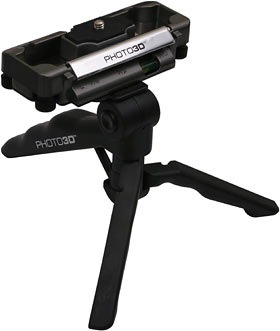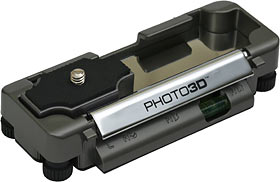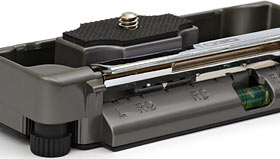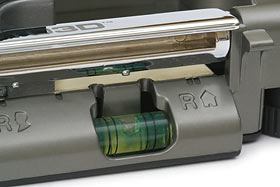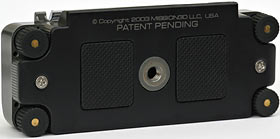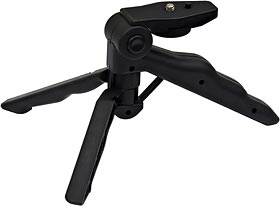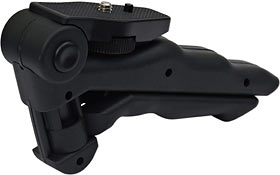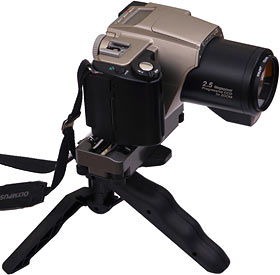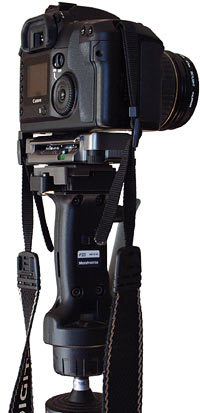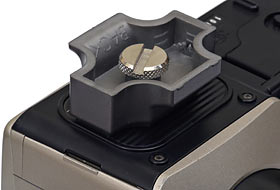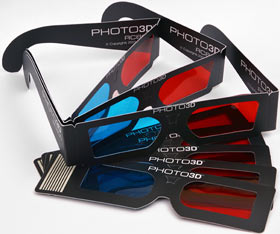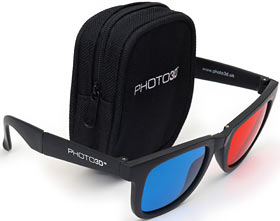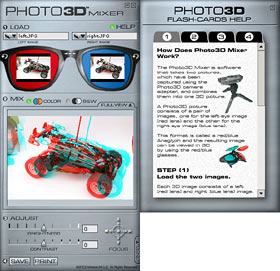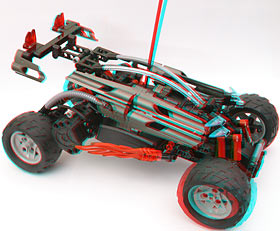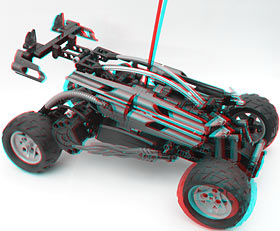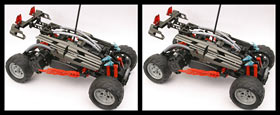
Mission3-D Photo3-D 303
Review date: 15 October 2003.Last modified 03-Dec-2011.
Do you have a digital camera?
Would you like to take 3D pictures with it?
If so, Mission3-D would like to draw your attention to this.
This hammer-headed tripod is the core of their Photo3-D 303 kit, which aims to streamline the 3D imaging process and allow anybody to take great looking 3D photos.
The capture side of 3D photography is, actually, simple enough. You just need two images, taken with the same settings (field of view and exposure), but from different horizontal locations. Take one picture, move the camera horizontally (a little bit for close-ups, more for long shots) without changing its heading, and then take another picture.
If you're shooting something that won't sit still, you need a camera with two lenses. There are lots of products in this field, ranging from very expensive through fairly expensive to relatively cheap. If the subject doesn't move, though, you can use any camera that'll let you lock its exposure settings.
The Photo3-D 303 kit simplifies the camera-sliding process with this adapter. You attach your camera to it with a removable mounting plate - the same attachment system that every good tripod uses - but the plate can slide from side to side.
A clamp bar across the back of the adapter flips up to release the plate. Push the bar back down and the plate's locked in place.
The back of the plate has an indicator mark on it, and there are matching guide marks to match on the adapter, which make it easier to consistently move the camera appropriate amounts for close-up, portrait and landscape shots.
It's important that the adapter be level, or your 3D will be wonky. Hence, this bubble level.
You don't have to use the adapter with a tripod; it has four screw-down rubber feet that allow it to stand on surfaces by itself, though obviously not if you've loaded it up with a big overhanging camera. When you do want to attach it to a tripod, it screws on just like a camera, with a standard socket on the bottom.
This is the tripod that comes with the Photo3-D kit. It's a lightweight non-extensible plastic unit, unsuitable for large cameras, but most digital cameras aren't large.
The tripod's main claim to fame...
...is that it folds up like this. With the legs folded you can hold the tripod like a pistol, so it's pretty easy to manage the camera with the tripod attached all the time.
This is my old Olympus C-2500L (reviewed, many moons ago, here) on the Photo3-D kit. It's about as big a camera as the tripod and adapter can comfortably handle...
...but with a beefier tripod, you can use a beefier camera.
The adapter wasn't really happy with my EOS-D60 on it, but it survived.
The mounting plate, and the plastic-walled groove it runs in on the adapter, are a weak point of the Photo3-D kit. You can move the camera accurately, but you can't aim it very well; the plastic parts have too much slop, and the camera can wiggle about.
Fortunately, it's not hard to just eyeball the alignment of the camera on the adapter and make sure it's pointing pretty much straight forward when you take the shot. But this is still clearly not a precision, or heavy duty, piece of gear.
The Photo3-D kit lets you produce a few different kinds of 3D images - about which more in a moment - but it's based around good old anaglyph.
Anaglyph glasses are what everyone tends to think of when 3D glasses are mentioned. They actually run a pretty distant second to polariser arrangements, at least for cinematic 3D, but they're still where it's at for simple printed or on-screen stereographs.
One eye gets a red lens, and the other gets blue or green or, in this case, cyan (between blue and green). The two images are put through appropriately coloured filters and then blended with each other, and when you look at the result through the special glasses, they quite effectively restrict each eye's intended image to only that eye.
And, of course, they also add rather wiggy colour effects. But a lot of people get used to anaglyph quite quickly, and you can even show pretty good colour images, not just monochrome. Only parts of the image that're close in colour to the filters will look bad (OK in one eye, black in the other).
(If you've got an Nvidia 3D card, by the way, you can use anaglyph viewing with games. The Nvidia 3D Stereo driver, available for free from their download page, supports anaglyph!)
The basic Photo3-D 303 kit gives you the sliding attachment, the folding tripod, a nice set of plastic red-cyan glasses, three sets of paper glasses, five paper "viewers" (the ones with no earpieces), and one "3D Greetings card". That's a cardboard folder in which you can put your own 3-D print; it includes a pull-out viewer.
These are an option. They're fold-up 3D specs styled in imitation of Ray-Ban's Folding Wayfarer II, and they're one of several Mission3-D anaglyph viewing options. They fit in the little pouch, which you can hook to your belt or stick to something with some included double-sided tape.
Mission3-D say these are "some of the finest 3-D glasses ever made", and I dare say they are well matched to the Photo3-D package, but they didn't seem all that miraculous to me. Pretty much no blue at all made it through the red side of the specs, but some red did leak through the blue side.
That said, these glasses do work well with printed anaglyph images, just like Mission3-D promise. Anaglyphs on paper looked as good through the folding specs as I've ever seen an anaglyph look.
You also, of course, get some software.
This is "Photo3-D Mixer", and it's very easy to use, thanks to straightforward on-line step-by-step help. You load the images for left and right eyes (Mixer only supports BMP and JPG format), you mix the images in colour or black and white mode, you adjust focus (the relative alignment of the two images - the above screenshot shows them well out of alignment, right after the initial mixing), you optionally tweak brightness and contrast, and then you save and/or print your image. A full-screen preview mode makes the tweaking pretty easy the first time you do it, and a complete doddle every time after that.
(In case you're wondering what the thing I photographed is - it's this. Yes, it does rock, thanks for asking.)
All of this happens, by default, at the native resolution of the images you imported. Modern digital cameras can therefore give you some pretty humungous anaglyphs - the final result in this case, even after I cropped the image in another program to get rid of the wasted space around the car, was still more than 2400 pixels wide.
Mixer lets you save 320 by 240, 640 by 480, 800 by 600 and 1024 by 768 e-mailable versions of the images as well as the full-res version, though.
No, you won't get the 2400 pixel wide version by clicking this. You also won't get much of a show, if you don't have some red-cyan glasses to hand. Mission3-D address this by including a free offer with the Photo3-D package; they'll mail free paper viewers to up to five of your friends, if you use Mixer's e-mail function to pimp your exciting new acquisition to them.
The above image shows that this particular toy isn't a great subject for colour anaglyphic photography; its red shock absorbers and side-flames, and its transparent red and blue, ah, Technic Bionicle 1 x 3 Teeth with Axleholes, show up black for one eye.
In black and white, that problem goes away.
As well as anaglyphic images of various sizes, Mixer can also save your focussed (lined up and cropped) left and right files separately. And it supports three other 3D formats.
One of the formats is interlaced 3D, for systems that use shutter-glasses to black out the view of each eye when the other eye's half of the image is on show.
Modern PC shutter-glasses systems don't generally use interlace any more; they just display full-frame images in quick succession.
Mixer's other two formats are side-by-side 3D, one of which is the "parallel" kind for viewing with a Brewster stereoscope (you've probably used one; a View-Master is one). The other one's crosseyed side-by-side, where you cross your eyes so the two pictures turn into three; the illusory middle one is what you focus on.
The only difference between parallel and crosseyed side-by-side images, besides the likelihood of migraine headache, is which image goes on which side.
Here's a crosseyed stereogram from Mixer. The small version above is pretty easy to view; click it for an 800 pixel wide version that may require you to move back a bit from your monitor.
The whole Mixer experience is very pleasing. It Just Works. The only glitch I encountered was that it kept telling me, over and over, that my selected printer wasn't valid, because my print sharer box was turned off. No biggie.
The only class of no-special-display-required stereogram that Mixer doesn't support is the recently popularised "Space Wiggle" variety, which is surprisingly effective for such a simple technique, though obviously not suitable for printing unless you want to flip pages.
True 3D this jigglevision certainly ain't, but it's a lot less headache-inducing than anaglyphic.
Any image editing package that can save animated GIFs will let you produce jigglevision images.
(If nothing's jiggling, that's probably because you've got animations turned off in your Web browser preferences. I applaud this, as do others, but you're going to have to turn the cursed things back on if you want to view jigglevision GIFs.)
The damage, and how to reduce it
The basic Photo3-D 303 kit will set you back $US129, ex shipping, from the Photo3-D online store. The fancy folding glasses are $US19, and you can buy extra viewers and so on as well. Online orders at the moment seem to only be possible if you pay via PayPal.
Mission3-D's gear is all very nicely presented, well documented and pretty easy to use.
The trouble is, you can do everything it does just as well or better for rather less money.
Let's start with the hardware. The critical component of the Photo3-D setup is the slide adapter; it might be plasticky, but it's not the sort of thing you can buy from any old photographic retailer, right? Other 3D adapters are likely to be precision-machined specialist items that cost big bucks, yes?
Well, no, actually.
A set of "focusing rails" turned sideways becomes what stereographers call a "slide bar", and focusing rails are pretty easy to find. Read all about them as they relate to 3D here. That same site offers a few slide bars, which comfortably beat the Photo3-D adapter for solidity. Prices start at $US42.
You may need to add your own spirit level, but that won't break the bank.
The next most critical component is the software.
Windows users will be pleased to learn that they can get basically the same thing as Mixer for the princely sum of nothing at all. Takashi Sekitani's Anaglyph Maker is freeware, and has the same basic functionality as Mixer.
Like Mixer, Anaglyph Maker speaks only JPG and BMP. Like Mixer, it lets you fiddle with focus, brightness and contrast, and can make black and white or colour anaglyphs and interlaced 3D images, and can print directly.
Unlike Mixer, though, Anaglyph Maker also supports red-green and red-blue anaglyphs as well as red-cyan. It doesn't have a full-screen preview, but its preview window automatically takes up most of the screen, and is more than good enough.
Anaglyph Maker can't spit out auto-scaled files for e-mail, or crosseyed or straight-on stereoscopic pairs, but all of that stuff can be done quickly and easily in any image editing package. And you can get one of those for free too.
(A Slashdot post clued me in to the existence of Callipygian 3D, as well. Also free, but it currently only works on WinXP.)
Want a tripod?
Well, if you want a little one, you can get one that's a bit bigger and much stronger than a folding plastic one for less than $US40. One much the same size as Mission3-D's will cost you less than $US20. Or you could head off to eBay and browse tons of options, many of which are about as good as the Mission3-D offering and sell for only a few bucks.
Want anaglyph glasses?
Yup, you can get those cheap as well. Are they as good as the Mission3-D ones? Maybe, maybe not. Even if you drop $US20 on a set of Mission3-D glasses, though, you're still going to be well ahead using the other penny-pinching options rather than buying a Photo3-D kit.
Overall
I'm being so hard on the Photo3-D because Mission3-D give it such a hard sell. They claim it's the "First Ever 3-D Attachment for Digital Cameras".
Well, no it isn't. People have been doing 3D with digital cameras, in various ways, for about as long as there have been digital cameras, and they've been using much the same gear as they used to use with film cameras. The Photo3-D may be the first 3D adapter to feature the word "Digital" all over the box and come with software, but that's not quite as dramatic an innovation as Mission3-D imply.
If you ignore the hype, the Photo3-D still stands as a well integrated, good looking, easy to use one-stop 3D photography solution for Windows users.
Personally, though, I don't think these fine qualities entirely compensate for its chintzy construction and high price.
Sure, if you've bought a fancy digital camera already, then $US129 may not make a lot more impact on your pocketbook. But I wouldn't mind buying a 3D setup in a few more separate transactions, seeing as doing that would get me a better setup that cost me less.
If you're looking for a gift for The Digital Photographer Who Has Everything, a Photo3D may indeed hit the spot.
If you're shopping for yourself, though, I'd explore other options.
Review Photo3D 303 kindly provided by Mission3-D.
